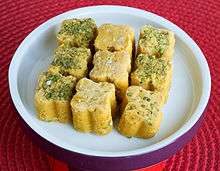Nan-e Nokhodchi
Nan-e nokhodchi (Persian: نان نخودچی), also called shirini nokhodchi (Persian: شیرینی نخودچی),[1] are cookies made from chickpeas originating in Qazvin, Iran.[2] These are traditionally made from chick-pea flour and flavored with cardamom and garnished with pistachio.[3] They come in varying shapes.
 Shirini-e Nokhodchi | |
| Type | Shortbread |
|---|---|
| Place of origin | |
| Main ingredients | Chickpea flour, sugar, pistachio, cardomom |
Etymology
Nan-e Nokhodchi means "chickpea bread" in Persian. Shirini Nokhodchi means "chickpea cookie" in Persian.
Shape
Some say they are traditionally cut into the shape of a clover,[1] while others say that the traditional shape is modeled after a hazelnut with etched designs.[4] They are also now made into squares, hearts and diamonds.[4]
Seven Sweets
According to legend, King Jamshid discovered sugar on the Persian new year, Nowruz. Therefore, there is the custom to celebrate Nowruz with seven sweet foods, in addition to the traditional other seven foods at the Haft-sin.[3] The seven sweets are:
- Noghl, sugar-coated almonds flavored with rose water
- Persian Baklava, pistachio almond pastry
- nan-e berenji, rice cookies
- Nan-e badami, almond cookies
- Nan-e nokhodchi, chickpea cookies
- Sohan asali, honey almonds
- Nan-e gerdui, walnut cookies
References
- Marks, Gil. (2010). Encyclopedia of Jewish food. Hoboken, N.J.: Wiley. ISBN 978-0-470-39130-3. OCLC 501320645.
- "Top rated snacks and souvenirs in Iran as things to eat". iraniandishes.ir. Retrieved 2020-05-31.
- "A Cookie for Every Country: Iran: Nan-e Nokhodchi". A Cookie for Every Country. Retrieved 2020-05-26.
- Bāzargān, Ṣoḡrā (December 15, 1993). Cookies. VI (Last Revision: October 28, 2011 ed.). Encyclopædia Iranica. pp. 244–246.